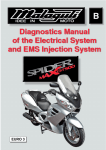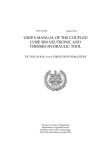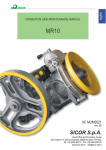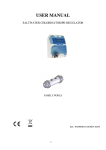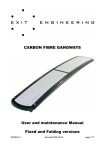Download MO Xtm-Xsm 50 Troubleshooting ENG
Transcript
B ELECTRIC SYSTEM TROUBLESHOOTING XTM - XSM WORKSHOP MANUALS B - TROUBLESHOOTING ELECTRIC SYSTEM TROUBLESHOOTING Introduction B CHAPTER B ELECTRICAL SYSTEM TROUBLESHOOTING 12.03 ISSUE PAGE SECTION 1 ENGLISH INTRODUCTION ............................................................................................................................................... 4 Manual updates ........................................................................................................................................ 4 Notes for easy consultation ...................................................................................................................... 4 Page layout ...................................................................................................................................... 4 Modified pages ................................................................................................................................. 5 Additional pages ............................................................................................................................... 5 Editing symbols ................................................................................................................................ 5 Abbreviations .................................................................................................................................... 7 TROUBLESHOOTING ...................................................................................................................................... 8 Wiring diagram ......................................................................................................................................... 8 Connection of the switches described in this manual ..................................................................... 9 Ignition system circuit .............................................................................................................................10 Ignition system troubleshooting ....................................................................................................... 11 Charging system circuit ........................................................................................................................... 12 Charging system troubleshooting .....................................................................................................13 Light system circuit ................................................................................................................................. 14 Light system troubleshooting ...........................................................................................................15 Signalling system circuit ......................................................................................................................... 20 Turn indicator troubleshooting .......................................................................................................... 21 Stop light troubleshooting ................................................................................................................ 23 Horn troubleshooting ........................................................................................................................ 24 Water temperature probe troubleshooting ...................................................................................... 25 Mixture oil indicator light troubleshooting ....................................................................................... 25 fuel reserve indicator light troubleshooting ........................................................................................ 26 Neutral indicator light troubleshooting .............................................................................................. 26 Speedometer sensor troubleshooting ...............................................................................................26 MODE button troubleshooting ........................................................................................................ 26 Revolution counter troubleshooting ..................................................................................................27 Configuration of the digital instrument connector ......................................................................................27 Electrical component layout ....................................................................................................................28 3 B - TROUBLESHOOTING B ELECTRIC SYSTEM TROUBLESHOOTING Introduction CHAPTER • Malaguti reserves the right to make any and all changes to its vehicles as it deems fit and appropriate at any time without prior notice. • No part of this publication, whether text or illustrations, may be reproduced or circulated. Malaguti reserves all rights over this publication. Reasons must be given for any request for permission (written) thereto. FIRST EDITION: 05/03 INTRODUCTION • This publication describes all necessary steps for troubleshooting concerning the electrical system (of the models indicated on the front page) and of the possible service operations, which are necessary for their solution. It supplies the trade technicians (authorised customer service centres) with the necessary information for operating in compliance with the modern concepts of “good practice” and “safety at work”. ENGLISH • Further information can be derived from the “Chassis” workshop manual - from the “Engine” workshop manual - from the Spare Parts catalogue. • All described operations must be performed by technicians with the necessary skill and experience. • The steps for the removal of body parts and of electrical and mechanical components, to allow access to wiring or electric components to service, can be taken from the Chassis Workshop Manual. • We recommend you follow the information given in this publication with care. • For any further information you may need, refer to the Malaguti S.p.A. Technical Department. MANUAL UPDATES • Updated pages of this publication will be delivered by us (in a reasonable time) already punched and therefore ready to be incorporated in the Manual. The superseded sheets should not be removed from the manual as they remain applicable to the servicing of pre-modified models. • The table of contents will be duly updated in the event that new pages are inserted, which render the consultation of the manual difficult. • IMPORTANT! The Electrical System Troubleshooting Manual is to be considered as an essential tool to be properly kept up-to-date so as to maintain its “validity” over time. NOTES FOR EASY CONSULTATION PAGE LAYOUT 4 Y Chapter X Section title W Page N° Z Date of issue PAGE SECTION 1 ISSUE 05.03 B - TROUBLESHOOTING ELECTRIC SYSTEM TROUBLESHOOTING Introduction Z B Y ENGLISH X CHAPTER W MODIFIED PAGES • Modified pages shall bear the same number as those in the previous edition /pre-modified ones, followed by the letter M, with the date of issue appearing in the appropriate box. • Modified pages may contain new illustrations; in this case, the added illustration (or illustrations) will bear the number of the illustration on the former page, followed by a letter. ADDITIONAL PAGES • Any additional pages shall bear the last number of the section to which they belong, followed by the letter A and the date of issue. EDITING SYMBOLS • Symbols have been provided for quick and easy reference (see page 6), identifying situations requiring utmost attention or providing practical suggestions or simple information. • These symbols may appear next to a text (in which case they refer solely to the text itself), next to a figure (in which case they refer to the topic illustrated in the figure and to the relative text), or at the top of the page (in which case they refer to all the topics dealt with in the page). Note: The meaning of the symbols should be duly memorised as their scope is to avoid having to repeat basic technical concepts or safety recommendations. They are therefore to be considered as veritable “memory tags”. In case of any doubt as to their meaning, consult the page in which they are fully described. 05.03 ISSUE PAGE SECTION 1 5 B - TROUBLESHOOTING ELECTRIC SYSTEM TROUBLESHOOTING B CHAPTER A) Introduction CAUTION! Recommendations and precautions regarding rider safety and motor vehicle integrity. A B) C) WARNING! Situations entailing the risk of personal injury to maintenance or repair mechanics, other workshop personnel or third parties, or damage to environment, vehicle or equipment. B FIRE HAZARD Indicates operations which may constitute a fire hazard. C ENGLISH D) RISK OF EXPLOSION Indicates operations which may constitute a risk of explosion. D E) F) TOXIC FUMES Indicates a possibility of intoxication or inflammation of the upper respiratory tract. E MECHANICAL MAINTENANCE Operations to be performed only by an expert mechanic. F G) H) ELECTRICAL MAINTENANCE Operations be performed only by an expert electrical/electronic technician G NO! Operations to be absolutely avoided H I) ENGINE SERVICE MANUAL Indicates information which may be obtained by referring to said manual. I M L) 6 SPARE PARTS CATALOGUE Indicates information which may be obtained by referring to said catalogue PAGE SECTION 1 L R ISSUE 05.03 B - TROUBLESHOOTING ELECTRIC SYSTEM TROUBLESHOOTING Introduction CHAPTER B ABBREVIATIONS F Cs P Pr S Sc T V Figure Tightening torque Page Paragraph Section Diagram Table Screw ENGLISH Note: The letter V in the illustrations refers to retaining or adjusting screws. The number following this letter refers to the number of the same type of screw in the unit or component described and illustrated. Letters not followed by a number indicate a single screw. In case of different screws being referred to in the illustration, the letter V is followed by a number and a small letter, for instance: (V4a). Unless otherwise specified, units and components are reassembled by proceeding in the reverse order of removal. Before any servicing, make sure that the motorbike is perfectly stable. The front wheel should preferably be anchored to the equipment (A - F 4) integral with the lifting board. A F4 05.03 ISSUE PAGE SECTION 1 7 B - TROUBLESHOOTING B ELECTRIC SYSTEM TROUBLESHOOTING CHAPTER Troubleshooting WIRING DIAGRAM ENGLISH 8 PAGE SECTION 2 ISSUE SECTION 2 02.04 B - TROUBLESHOOTING ELECTRIC SYSTEM TROUBLESHOOTING Troubleshooting CHAPTER B CONNECTION OF THE SWITCHES DESCRIBED IN THIS MANUAL AR B -MA RH CONTROL This manual contains connection diagrams, like the one illustrated hereby, which illustrate how switch terminals should be connected (key switch, brake switch, MODE button, etc.). OFF ON The first column from the left indicates the different positions of the switch, the top line the colour of the wires connected to the switch terminals. MODE The symbol “ ” identifies terminals in which there is a condition of continuity, i.e. a closed circuit, in a certain position of the switch. ENGLISH In this diagram: “B-MA and AR”: there is continuous contact when the switch is “ON”. 05.03 ISSUE PAGE SECTION 2 SECTION 2 9 B - TROUBLESHOOTING B ELECTRIC SYSTEM TROUBLESHOOTING CHAPTER Troubleshooting IGNITION SYSTEM CIRCUIT ENGLISH 10 PAGE SECTION 2 ISSUE SECTION 2 02.04 B - TROUBLESHOOTING ELECTRIC SYSTEM TROUBLESHOOTING Troubleshooting CHAPTER B A) Check resistance of the spark plug cap - Detach the spark plug cap from the H.V. cable and connect the tester (kΩ) as follows (F1): - Tester (+) terminal side 1 - Tester (-) terminal side 2 - Spark plug cap resistance: 5 kΩ (20°C) - Not compliant: replace the spark plug cap F1 B) Check resistance of the electronic control unit - Connect the tester (kΩ) to the control unit as follows (F2): - Tester (+) terminal H.V. cable - Tester (-) terminal lead terminal (green cable) - Secondary winding resistance: 5-6 kΩ (20°C) - Not compliant: replace the control unit F2 ENGLISH IGNITION SYSTEM TROUBLESHOOTING FLYWHEEL C) Check resistance of power supply cable (green cable) - Connect the tester (Ω) to the flywheel as follows (F3): - Tester (+) terminal green cable - Tester (-) terminal white cable - Power supply resistance: 640-780 Ω (20°C) - Not compliant: replace the flywheel magneto MAGNETO F3 D) Check pick-up resistance (red cable) - Connect the tester (Ω) to the flywheel as follows (F4): - Tester (+) terminal red cable - Tester (-) terminal white cable - Pick-up resistance: 100-140 Ω (20°C) - Not compliant: replace the flywheel magneto FLYWHEEL MAGNETO F4 E) Check key switch - Disconnect the connector and connect the tester (Ω): 1) - Tester (+) terminal KEY OFF KEY ON KEY ON -1ST CLICK 2ND CLICK red/white cable CONTINUITY DISCONTINUITY DISCONTINUITY Up to chassis n° 7086713 2) - Tester (+) terminal KEY OFF KEY ON KEY ON -1ST CLICK 2ND CLICK orange cable DISCONTINUITY CONTINUITY DISCONTINUITY Up to chassis n° 7086713 3) - Tester (+) terminal KEY OFF KEY ON KEY ON -1ST CLICK 2ND CLICK Up to chassis n° 7086713 yellow cable DISCONTINUITY CONTINUITY CONTINUITY - Tester (-) terminal KEY OFF KEY ON blue cable CONTINUITY DISCONTINUITY From chassis n° 7086714 - Tester (-) terminal KEY OFF KEY ON green cable DISCONTINUITY CONTINUITY From chassis n° 7086714 - Tester (-) terminal KEY OFF KEY ON green/black cable DISCONTINUITY CONTINUITY From chassis n° 7086714 WARNING: if the white/black cable leading from the switch is grounded, the motor does not start. 02.04 ISSUE PAGE SECTION 2 SECTION 2 11 B - TROUBLESHOOTING B ELECTRIC SYSTEM TROUBLESHOOTING CHAPTER Troubleshooting CHARGING SYSTEM CIRCUIT ENGLISH 12 PAGE SECTION 2 ISSUE SECTION 2 02.04 B - TROUBLESHOOTING ELECTRIC SYSTEM TROUBLESHOOTING Troubleshooting CHAPTER B CHARGING SYSTEM TROUBLESHOOTING If the battery is still flat, after it has been replaced or recharged, proceed as follows: A) Check charging voltage - Connect the tester (20 V DC) to the battery as in (F5): Tester (+) terminal + battery pole Tester (-) terminal - battery pole Start the engine at approx. 7000 RPM Voltage measured 13.5-14V Not compliant: continue searching F5 ENGLISH B) Check the flywheel magneto charging coil FLYWHEEL - Disconnect the connectors from the flywheel magneto and connect the tester (Ω) as follows (F6): - Tester (+) terminal yellow cable - Tester (-) terminal white cable - Charging coil resistance: 0.2-0.4Ω (20°C) - Not compliant: replace the flywheel - Compliant: continue searching F6 C) Check that the cables have been connected to the regulator connector in the right sequence (see wiring diagram). D) Check continuity (tester Ω) of the yellow/purple cable leading from the flywheel to the regulator. E) Check continuity of the yellow cable (tester Ω) leading from the regulator to the battery (pole +). F) Check continuity (tester Ω) of the black grounding cable connected to the regulator connector. G) Check the rectifier diode (F7) The diode is under the seat, connected to the yellow cable leading to the (+) pole of the battery. - Remove the diode and connect the tester ( follows: - Tester (+) terminal terminal 1 - Tester (-) terminal terminal 2 - The value measured must be ( 435) - Not compliant: replace the diode ) as F7 WARNING: to avoid troublesome inconveniences on electrical components, make sure the diode is fitted before connecting the battery. H) If all checks have positive results, replace the regulator. 05.03 ISSUE PAGE SECTION 2 SECTION 2 13 B - TROUBLESHOOTING B ELECTRIC SYSTEM TROUBLESHOOTING CHAPTER Troubleshooting LIGHT SYSTEM CIRCUIT ENGLISH 14 PAGE SECTION 2 ISSUE SECTION 2 02.04 B - TROUBLESHOOTING ELECTRIC SYSTEM TROUBLESHOOTING Troubleshooting CHAPTER B LIGHT SYSTEM TROUBLESHOOTING WARNING: the vehicle’s lights come on when the key is in its “ON” position. If the lights do not work, proceed as follows: A) Check the light coil resistance (F8) FLYWHEEL - Disconnect the flywheel connector and connect the tester (Ω): Tester (+) terminal yellow cable Tester (-) terminal white cable Light coil resistance: 0.2_0.4Ω (20°C) Not compliant: replace the flywheel Compliant: continue searching ENGLISH - F8 B) Make sure that the cables of the regulator connector are correctly positioned and firmly secured in place (see wiring diagram). C) Check continuity (tester Ω) between the yellow cable leading from the flywheel and the purple/ yellow cable leading to the regulator. D) Check ground continuity (tester Ω) between the black cable in the regulator and a grounded point of the frame (to be tested after disconnecting the regulator terminal board). E) Check the voltage regulator (F9) - Connect the tester (AC) to the regulator connector (leaving the latter plugged in) - Tester (+) terminal purple/yellow cable - Tester (-) terminal black cable - Start the engine at 7000 RPM - The voltage measured should be: 12 volts - Not compliant: replace the regulator - Compliant: continue searching F9 F) Check continuity (tester Ω) of the yellow cable leading from the regulator to the key switch. G) Check the key switch (see page 11). (SWITZERLAND version only) Check continuity (tester Ω) of the pink cable leading from the key switch to the left hand switch. If there is no continuity, replace the left hand switch. 02.04 ISSUE PAGE SECTION 2 SECTION 2 15 B - TROUBLESHOOTING B ELECTRIC SYSTEM TROUBLESHOOTING CHAPTER Troubleshooting If the headlights are not working, proceed as follows: A) Check continuity of the lamp and lamp socket - Discontinuity: replace the lamp and/or lamp socket - Continuity: continue searching ENGLISH B) Check voltage delivered to the front lamp socket - Connect the tester (20V AC) to the lamp socket - Tester (+) terminal pink cable - Tester (-) terminal black cable - Turn the key to “ON”. - Start the engine at 7000 RPM - The voltage measured should be: 12 volts - Not compliant: continue searching. C) Check continuity of the pink cable Ω) to the pink cable leading from the key switch to the headlight connector. - Connect the tester (Ω - No continuity: the pink cable is interrupted. Repair (see wiring diagram). - Continuity: black cable interrupted. Repair by providing a jumper between the black cable connected to the headlight and a grounded point of the frame. (SWITZERLAND version only - If the front parking light does not work) Check continuity of the pink cable Ω) to the pink cable leading from the key switch to the parking light lamp socket. - Connect the tester (Ω - No continuity: the pink cable is interrupted. Repair (see wiring diagram) - Continuity: black cable interrupted. Repair by providing a jumper between the black cable connected to the parking light lamp socket and a grounded point of the frame. If the low beam is not working, proceed as follows: A) (SWITZERLAND version only) Check continuity of the lamp - Discontinuity: replace the lamp. B) (SWITZERLAND version only) Check left hand switch. Ω) to the switch as follows: Connect the tester (Ω - Tester (+) terminal white/blue cable - Tester (-) terminal pink cable - Turn the switch light to the “LO” symbol. - No continuity: replace the left hand switch. - Continuity: the white/blue cable leading from the left hand switch to the lamp socket is interrupted. Repair (see wiring diagram) 16 PAGE SECTION 2 ISSUE SECTION 2 02.04 B - TROUBLESHOOTING ELECTRIC SYSTEM TROUBLESHOOTING Troubleshooting CHAPTER B If the low beam light is not working but the low beam indicator light is, proceed as follows: A) (SWITZERLAND version only) Check continuity of the lamp - Discontinuity: replace the lamp. B) (SWITZERLAND version only) Check continuity of the blue cable leading from the left hand switch to the lamp socket. - No continuity: repair the blue cable (see wiring diagram). ENGLISH If the low beam light and indicator light are not working, proceed as follows: A) (SWITZERLAND version only) Check left hand switch. Ω) to the switch as follows: Connect the tester (Ω - Tester (+) terminal blue cable - Tester (-) terminal pink cable - Turn the light switch to the “HI” symbol. - No continuity: replace the left hand switch. If the low beam indicator light is not working, proceed as follows: A) (SWITZERLAND version only) Check continuity of the light bulb - Discontinuity: replace the light bulb. B) (SWITZERLAND version only) Check continuity of the blue cable leading from the left hand switch to the lamp socket of the instrument board indicator light. - No continuity: the blue cable is interrupted. Repair (see wiring diagram) - Continuity: there is no grounding point. Repair by providing a jumper between the black cable connected to the lamp socket and a grounded point of the frame. 02.04 ISSUE PAGE SECTION 2 SECTION 2 17 B - TROUBLESHOOTING B ELECTRIC SYSTEM TROUBLESHOOTING CHAPTER Troubleshooting If the tail light does not work, proceed as follows: A) Check continuity of the lamp - Discontinuity: replace the lamp B) Check the voltage delivered to the rear lamp socket ENGLISH - Connect the tester (AC 20V) to the lamp socket (F10) Tester (+) terminal pink cable Tester (-) terminal black cable Turn the key to “ON”. Start the engine at 7000 RPM The voltage measured should be: 12 volts Not compliant: continue searching F10 C) Check continuity of the pink cable - Ω) as follows (F11): Connect the tester (Ω Tester (+) terminal terminal 1 Tester (-) terminal terminal 2 No continuity: the pink cable leading from the key switch to the tail light is interrupted. Repair (see wiring diagram). PARKING LIGHTS STOP LIGHTS F11 WARNING: if the ground connection is lacking (black cable), the stop light will not come on either. 18 PAGE SECTION 2 ISSUE SECTION 2 02.04 B - TROUBLESHOOTING ELECTRIC SYSTEM TROUBLESHOOTING Troubleshooting CHAPTER B If the number plate light is not working, proceed as follows: A) (SWITZERLAND version only) Check continuity of the lamp and lamp socket. - Discontinuity: replace the lamp and/or lamp socket. - Continuity: continue searching. ENGLISH B) (SWITZERLAND version only) Check continuity of the pink cable Ω) between the pink cable of the tail light lamp socket and the pink cable of the number - Connect the tester (Ω plate light lamp socket. - No continuity: the pink cable is interrupted. Repair (see wiring diagram) - Continuity: there is no grounding point. Repair by providing a jumper between the black cable connected to the lamp socket and a grounded point of the frame. 02.04 ISSUE PAGE SECTION 2 SECTION 2 19 B - TROUBLESHOOTING B ELECTRIC SYSTEM TROUBLESHOOTING CHAPTER Troubleshooting SIGNALLING SYSTEM CIRCUIT ENGLISH 20 PAGE SECTION 2 ISSUE SECTION 2 02.04 B - TROUBLESHOOTING ELECTRIC SYSTEM TROUBLESHOOTING Troubleshooting CHAPTER B TURN INDICATOR TROUBLESHOOTING If the turn indicators do not blink, proceed as follows: A) Check the turn indicator switch (F12) - Disconnect the 5-way connector from the left hand switch (tester Ω). - Put the button in left hand indicator position - Tester (+) terminal - Tester (-) terminal brown cable purple cable - Put the button in right hand indicator position brown cable green cable ENGLISH - Tester (+) terminal - Tester (-) terminal - There must be continuity in both cases - No continuity: replace the left hand switch - Continuity: continue searching. F12 B) Check the voltage delivered to the flashlight (F13) - Disconnect the flashlight connector and connect the 20 V DC tester: - Tester (+) terminal blue cable - Tester (-) terminal cable grounded to frame - Turn the key “ON” - Voltage =0: blue cable interrupted. Repair (see wiring diagram). - Voltage 12 Volts: continue searching. F13 C) Check continuity of brown cable - Connect the OHM tester between the terminal plugged into the flashlight connector and the terminal plugged into the 5-way connector of the left hand switch; both connectors must be disconnected. - Continuity: replace the flashlight. - No continuity: brown cable interrupted Repair (see wiring diagram). 05.03 ISSUE PAGE SECTION 2 SECTION 2 21 B - TROUBLESHOOTING B ELECTRIC SYSTEM TROUBLESHOOTING CHAPTER Troubleshooting Check the voltage delivered to the lamp socket connector of the turn indicators; proceed as follows: A) Check the right indicator (F14) RIGHT TURN INDICATOR - Disconnect the terminal of the right hand lamp socket and connect the tester (20V DC): - Tester (+) terminal green cable - Tester (-) terminal black cable - Key switch in “ON” position - Put the switch in right hand indicator position: - Voltage 12 Volts: compliant - Not compliant: the circuit between the turn indicator switch and the lamp socket connector is faulty. Repair (see wiring diagram). ENGLISH F14 B) Check left indicator (F15) LEFT TURN INDICATOR - Disconnect the left lamp socket terminal and connect the tester (20 V DC): - Tester (+) terminal purple cable - Tester (-) terminal black cable - Key switch in “ON” position - Put the switch in left hand indicator position - Voltage 12 Volts: compliant - Not compliant: the circuit between the turn indicator switch and the lamp socket connector is faulty. Repair (see wiring diagram). F15 22 PAGE SECTION 2 ISSUE SECTION 2 05.03 B - TROUBLESHOOTING ELECTRIC SYSTEM TROUBLESHOOTING Troubleshooting CHAPTER B STOP LIGHT TROUBLESHOOTING If the stop light is not working, proceed as follows: A) Check continuity of the lamp and lamp socket with a tester (Ω) - Discontinuity: replace the lamp or lamp socket - Continuity: continue searching B) Check front and rear stop light switch STOP SWITCH ENGLISH - Disconnect the red and blue terminals and connect the tester (Ω) to the switch terminals (F16). - Tester (+) terminal terminal 1 - Tester (-) terminal terminal 2 - Operate the brake lever. - Discontinuity: replace the stop light switch. - Continuity: continue searching. F16 C) Check the voltage delivered to the blue cable inserted in the stop light switch (20 V DC tester) (F17) STOP SWITCH - Tester (+) terminal blue cable Tester (-) terminal grounded to the frame Turn the key “ON” The voltage measured should be: 12 Volts. Not compliant: blue cable interrupted. Repair (see wiring diagram) - Compliant: continue searching. GROUNDED F17 D) Check continuity of the red cable between the terminal inserted in the stop switch and the terminal inserted in the tail light. STOP SWITCH - Discontinuity: red cable interrupted. Repair (see wiring diagram) (F18). WARNING: if the grounding connection is lacking, the tail light will not come on either. TAIL AND STOP LIGHTS F18 05.03 ISSUE PAGE SECTION 2 SECTION 2 23 B - TROUBLESHOOTING B ELECTRIC SYSTEM TROUBLESHOOTING CHAPTER Troubleshooting HORN TROUBLESHOOTING If the horn is not working, proceed as follows: LEFT HAND SWITCH BLOCK A) Check the “HORN” button - Disconnect the 5-way connector from the left hand switch and connect the tester (Ω) (F19) - Tester (+) terminal orange terminal - Tester (-) terminal black terminal - Press the “HORN” button - Discontinuity: replace the left hand switch - Continuity: continue searching. OHM ENGLISH F19 B) Check grounding of the black cable of the 9-way switch of the harness - Connect the OHM tester as follows: Tester (+) terminal black cable Tester (-) terminal grounded to frame No continuity: black cable interrupted. Repair by providing a jumper between the black cable and a grounded point of the frame. - Continuity: continue searching. C) Check voltage delivered to the horn - Disconnect the terminals of the horn and connect the tester (20V DC) (F20) blue terminal - Tester (+) terminal - Tester (-) terminal orange terminal - Key switch in “ON” position - Press the “HORN” button - Voltage 12V: replace the horn. - No power: continue searching. F20 D) Check voltage delivered to blue cable (F21) (20 V DC Tester) - Tester (+) terminal blue terminal Tester (-) terminal grounded to frame Key switch in “ON” position No power: blue cable interrupted: repair (see wiring diagram). Voltage 12V: orange cable interrupted between the terminal inserted in the 5-way connector of the harness and the terminal inserted in the horn. Repair (see wiring diagram). F21 24 PAGE SECTION 2 ISSUE SECTION 2 05.03 B - TROUBLESHOOTING ELECTRIC SYSTEM TROUBLESHOOTING Troubleshooting CHAPTER B WATER TEMPERATURE PROBE TROUBLESHOOTING If the motor is hot and the instrument’s indicator is reading 0, proceed as follows: - Disconnect the white/green cable of the water temperature probe and ground it: A) Red light on and digital temperature scale at maximum level: - Replace the water temperature probe (on the head). B) Red light blinking and digital temperature scale signalling only one notch: - Check continuity (tester Ω) of the white/green cable leading from the water temperature probe to the digital instrument. - Continuity: replace the digital instrument. - Discontinuity: the white/green cable is interrupted. Repair (see wiring diagram). ENGLISH Warning: the red light will also blink if the white/green water temperature probe cable has come loose. MIXTURE OIL INDICATOR LIGHT TROUBLESHOOTING If the mixture oil indicator light only comes on in check mode, proceed as follows: A) Check the oil probe - Take the oil probe out of the tank, disconnect the connector and connect the OHM tester (F22). - Tester (+) terminal coupling 1 - Tester (-) terminal coupling 2 - Whilst keeping the probe upright, float “A” must run freely and position itself at the base of the probe. - Discontinuity: the probe is faulty. Repair. - Continuity: continue searching. F22 B) Check the grounding continuity of the black cable of the connector plugged into the probe - Disconnect the connector from the probe and connect the OHM tester (F23). - Tester (+) terminal black cable - Tester (-) terminal grounded to frame - Discontinuity: the black cable is interrupted. Repair by providing a jumper between the black cable and a grounded point of the frame. - Continuity: the white cable leading from the probe to the digital instrument is interrupted. Repair (see wiring diagram). F23 05.03 ISSUE PAGE SECTION 2 SECTION 2 25 B - TROUBLESHOOTING B ELECTRIC SYSTEM TROUBLESHOOTING CHAPTER Troubleshooting FUEL RESERVE INDICATOR LIGHT TROUBLESHOOTING If the fuel reserve indicator light only comes on in check mode, proceed as follows: A) Disconnect the probe connector and provide a jumper between the grey cable and the black cable. - Turn the switch “ON”. - Light on: replace the petrol probe. - Light off: continue searching. B) Check grounding continuity (tester Ω) between the black cable and a grounded point of the frame. - Discontinuity: black cable interrupted. Repair by providing a jumper between the black cable and a grounded point. - Continuity: the cable leading from the probe to the digital instrument is interrupted. Repair (see wiring diagram). ENGLISH NEUTRAL INDICATOR LIGHT TROUBLESHOOTING A) The neutral light stays on, even if the vehicle is in gear. - Check whether the red/black cable is grounded. - Disconnect the red/black cable of the “neutral” switch fastened to the motor casing and connect the tester (Ω) as follows: - Tester (+) terminal red/black cable - Tester (-) terminal grounded to frame - Continuity: red/black cable grounded. Repair. - Discontinuity: replace the “neutral” switch. B) The neutral light only comes on in check mode. - Check continuity (tester Ω) of the red/black cable leading from the neutral switch to the digital instrument. - Discontinuity: red/black cable interrupted. Repair. - Continuity: replace the “neutral” switch. SPEEDOMETER SENSOR TROUBLESHOOTING If speed is not signalled, proceed as follows: - make sure the digital instrument is correctly connected (see wiring diagram). - if the cables leading to the instrument’s connector are correctly inserted, replace the speedometer sensor and its electronic transmission. “MODE” BUTTON TROUBLESHOOTING If the functions of the digital instrument are not changed when the “Mode” button is pressed, proceed as follows: RIGHT HAND CONTROL A) Check the “MODE” button - Disconnect the 2-way connector of the “MODE” button and connect the OHM tester as follows (F24): - Tester (+) terminal terminal 1 - Tester (-) terminal terminal 2 - Press the “MODE” button - Discontinuity: replace the “MODE” button - Continuity: continue searching. F24 26 PAGE SECTION 2 ISSUE SECTION 2 05.03 B - TROUBLESHOOTING ELECTRIC SYSTEM TROUBLESHOOTING Troubleshooting CHAPTER B B) Check the power supply of the blue cable - Connect the tester (20V DC) as follows: - Tester (+) terminal blue cable - Tester (-) terminal grounded to the frame - Turn the switch “ON”: - Power measured must be 12 V. - Not compliant: the blue cable is interrupted. Repair (see wiring diagram). C) Check continuity of red cable (“MODE” pulse) - Connect the OHM tester as follows: - Tester (+) terminal red cable (“MODE” connector) - Tester (-) terminal red cable (digital instrument connector) Discontinuity: red cable interrupted. Repair (see wiring diagram). Continuity: replace the digital instrument. ENGLISH REVOLUTION COUNTER TROUBLESHOOTING Check continuity of the white/brown cable leading to the digital instrument and the purple/yellow cable leading from the flywheel magneto. Discontinuity: white/brown cable interrupted. Repair (see wiring diagram). Continuity: replace the digital instrument. CONFIGURATION OF THE DIGITAL INSTRUMENT CONNECTOR Pos. Meaning Colour Pos. Meaning Colour 1 Indicator green 10 Water probe white-green 2 Indicator purple 11 Under key blue 3 Neutral red/black 12 RPM white-brown 4 Lights pink 13 Negative black 5 Hall sensor input yellow/red 14 Battery positive terminals blue-red 6 MODE button red 15 Hall sensor GND black 7 NC - 16 Hall sensor VDC blue-black 8 Oil white 17 NC - 9 Fuel grey 18 NC - 05.03 ISSUE PAGE SECTION 2 SECTION 2 27 B - TROUBLESHOOTING B ELECTRIC SYSTEM TROUBLESHOOTING CHAPTER Troubleshooting ELECTRICAL COMPONENT LAYOUT ENGLISH 1) INSTRUMENT BOARD 2) HEADLIGHT 3) HORN 4) SWITCH WITH KEY 5) LEFT CONTROL 6) SPEEDOMETER SENSOR 7) FRONT RIGHT INDICATOR 8) FRONT LEFT INDICATOR 9) RIGHT CONTROL 10) WATER TEMPERATURE PROBE 11) REAR STOP SWITCH 12) OIL INDICATOR SWITCH 13) FUEL RESERVE SENSOR 14) FLY WHEEL MAGNETO 15) “CDI” CONTROL UNIT 16) REGULATOR 17) FLASHLIGHT 18) BATTERY 19) REAR RIGHT INDICATOR 20) TAIL AND STOP LIGHT 21) REAR LEFT INDICATOR 22) FRONT STOP SWITCH 23) NEUTRAL INDICATOR LEAD TERMINAL 28 PAGE SECTION 2 ISSUE SECTION 2 05.03 ELECTRIC SYSTEM TROUBLESHOOTING Troubleshooting B ENGLISH CHAPTER 05.03 ISSUE PAGE 29 B ELECTRIC SYSTEM TROUBLESHOOTING Troubleshooting CHAPTER ENGLISH 30 PAGE ISSUE 05.03 ELECTRIC SYSTEM TROUBLESHOOTING Troubleshooting B ENGLISH CHAPTER XTM - XSM 02.04 ISSUE PAGE 31 B ELECTRIC SYSTEM TROUBLESHOOTING Troubleshooting CHAPTER ENGLISH XTM - XSM 32 PAGE ISSUE 02.04


































